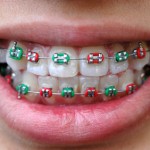
Orthodontic treatment whether carried out using fixed, removable or a mixture of orthodontic fixed and removable appliances is a common procedure. With the typical course of treatment lasting between 18-24 months, a range of non-conventional adjunctive approaches have been developed with the aim of trying to accelerate tooth movement.
The aim of this review was to assess the effect of non-surgical adjunctive interventions for accelerating the rate of orthodontic tooth movement and reducing the duration of orthodontic treatment.
Methods
Searches were conducted in the Cochrane Oral Health Group’s Trials Register, the Cochrane Central Register of Controlled Trials (CENTRAL), Medline, Embase, LILACS, the metaRegister of Controlled Trials , the US National Institutes of Health Trials Register and the WHO International Clinical Trials Registry Platform.
Randomised controlled trials (RCTs) of patients receiving orthodontic treatment using fixed appliances along with non- surgical adjunctive interventions to accelerate tooth movement were considered. Non-parallel design studies (e.g. split-mouth) were excluded because of the possibility of ‘cross-over’ effects. Rate of tooth movement and duration of treatment were the primary outcomes. Two reviewers independently assessed papers for inclusion, extracted data and study quality using the Cochrane risk of bias tool.
Results
- 2 RCTs assessed at being at high risk of bias were included.
- 2 studies, involving a total of 111 participants, compared the use of Tooth Masseuse and OrthoAccel with conventional treatment mechanics during orthodontic alignment and canine retraction phases.
- Using the Tooth Masseuse with 111 Hz at 0.06 Newtons (N) for 20 minutes daily resulted in greater reduction in irregularity in the lower incisor region over 10 weeks, assessed using Little’s Irregularity Index (LII) with a mean difference (MD) of 0.6 mm (95% confidence interval (CI) -0.94 to 2.34) when compared to the control group.
- Pain and discomfort increased at six to eight hours after arch wire placement and after seven days, with minimal difference between the intervention and control groups.
- No statistical tests were provided for either variable and the differences between the two groups were not clinically important.
- Using OrthoAccel with 30 Hz at 0.25 N for 20 minutes daily produced a higher rate of maxillary canine distalisation in comparison to the control group (MD 0.37 mm/month; 95% CI -0.07 to 0.81; P = 0.05).
- Whilst this difference suggested 50% faster tooth movement using the vibrational appliance, the absolute differences were marginal and deemed clinically unimportant.
- Similar levels of non-serious adverse effects were reported in the intervention and control groups with a risk ratio of 0.96 (95% CI 0.32 to 2.85).
- Quality of the evidence was very low so we cannot rely on the findings.
Conclusions
The authors concluded:
There is very little clinical research concerning the effectiveness of non-surgical interventions to accelerate orthodontic treatment. The available evidence is of very low quality and so it is not possible to determine if there is a positive effect of non-surgical adjunctive interventions to accelerate tooth movement. Although there have been claims that there may be a positive effect of light vibrational forces, results of the current studies do not reach either statistical or clinical significance. Further well-designed and rigorous RCTs with longer follow-up periods are required to determine whether non-surgical interventions may result in a clinically important reduction in the duration of orthodontic treatment, without any adverse effects.
Comments
This review has been conducted following the usual rigorous Cochrane methodology. Only two trials were identified providing unreliable evidence of the effectiveness of the intervention studies. As the authors note, previous reviews of this topic have included RCTs and controlled trials or included trials of a split-mouth design. The decision to focus only on parallel group studies for this review is correct in view of the potential for cross-over effects.
Despite the interest influencing the duration of orthodontic treatment, there is a dearth of good quality studies for both non-surgical approaches as highlighted in this review and surgical approaches as highlighted in a companion Cochrane review of surgical approached to accelerate orthodontic treatment published earlier this year (Dental Elf – 6th Jul 2015).
Links
Primary paper
El-Angbawi A, McIntyre GT, Fleming PS, Bearn DR. Non-surgical adjunctive interventions for accelerating tooth movement in patients undergoing fixed orthodontic treatment. Cochrane Database Syst Rev. 2015 Nov 18;11:CD010887. [Epub ahead of print] Review. PubMed PMID: 26576758.

Do non-surgical interventions to accelerate orthodontic treatment? https://t.co/zF31GKmZ7g
Little research on non-surgical interventions to accelerate orthodontic treatment https://t.co/zF31GKmZ7g
Little research on effectiveness of non-surgical interventions to accelerate orthodontic treatment https://t.co/zF31GKmZ7g
Non-surgical interventions to accelerate orthodontic treatment- little evidence https://t.co/zF31GKmZ7g
Little research on non-surgical adjuncts to accelerate orthodontic treatment https://t.co/zF31GKmZ7g
Don’t miss – little research on non-surgical interventions to accelerate orthodontic treatment https://t.co/zF31GKmZ7g
Little research on non-surgical interventions to accelerate orthodontic treatment https://t.co/eKfPMNyVp1 says @TheDentalElf
Little research on non-surgical interventions to accelerate orthodontic treatment https://t.co/I4Y4JZgyZu says @TheDentalElf
[…] Little research on non-surgical interventions to accelerate orthodontic treatment […]